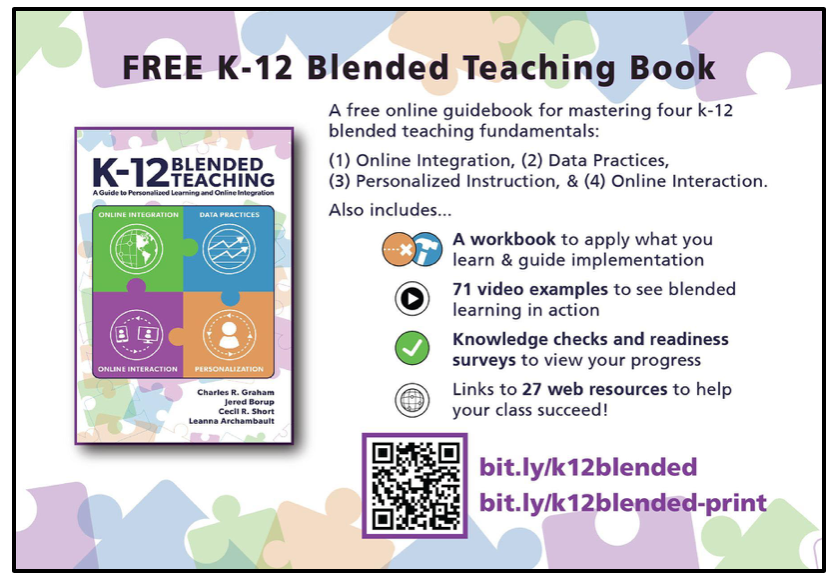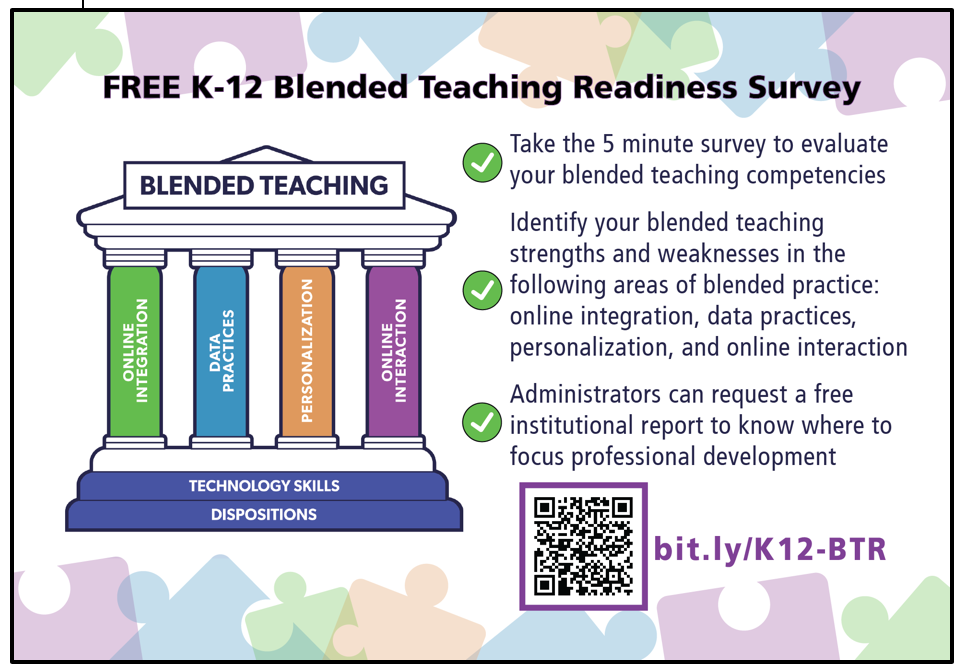K-12 Blended Teaching: A free guidebook for teachers
by Cecil R. Short, Charles R. Graham, Jered Borup, & Leanna Archambault
K-12 blended teaching is still maturing. Competencies and skills needed to effectively teach in the K-12 blended space continue to undergo development. While some states have already taken steps to require teaching competencies in blended contexts in order to earn licensure (Utah, Minnesota), there remains a gap in determining specific skills and resources that are needed (Pulham, Graham, & Short, 2018). This gap exists because blended learning is “typically more complicated and multifaceted than either fully online or face-to-face learning” (Bonk, Kim, & Zeng, 2004, p. 564). The learning curve for blended teaching is remarkably steep, and teachers need additional support to overcome the challenges (Patrick & Sturgis, 2015).
K-12 administrators and teachers need guidance for blending their school-wide and classroom practices. These stakeholders are limited by the resources that are available to them. Some books and resources can have a limited view of blended learning--often focusing on a specific type of blended learning--and are commonly focused on personal experience and not grounded in empirical research. Access to free, open educational resources (OER) that are research-based can make professional learning (PL) in this area more beneficial because they can be distributed widely without cost. Such resources not only provide PL professionals with materials that focus on developing the skills and knowledge needed for K-12 blended teaching, but also allow teachers to come away from PL with a resource they can continually turn to and adapt.
With this in mind, we created an open guide to K-12 blended teaching. K-12 Blended Teaching: A Guide to Personalized Learning and Online Integration is free to download and access online. It can serve as a guidebook for pre-service teachers learning how to teach in K-12 online and blended contexts and for in-service teachers and administrators looking to implement blended teaching practices in their classes. The book was finished in spring 2019 with plans for ongoing support and future editions.
K-12 Blended Teaching book can be freely accessed online at http://bit.ly/k12blended
The guidebook is designed with in-service and pre-service teachers in mind, written in a conversational tone with content that is relevant, practical, and engaging. Since the time teachers have for PL is scarce while the demand and skills required for blended environments are high, teachers need a resource they can consistently turn to on their own through every phase of their blended experience.
The guidebook is also founded on the latest research. Prior to creating the guidebook we conducted an extensive review of K-12 blended teaching competencies (Pulham & Graham, 2018; Pulham, Graham, & Short, 2018). Through several iterations, we addressed skills to build teachers’ competencies specific to blended contexts. In addition, the content was tested by over 100 pre-service teachers taking an undergraduate course that focused on K-12 online and blended teaching. As part of the review process, 18 blended teaching researchers and practitioners provided additional feedback. The input from these expert reviewers and practitioners guided revisions and inspired the inclusion of additional content, text features, and usability guidelines that are important to educators looking for ways to implement blended teaching.
As a result, the guide includes vignettes of teacher experiences, links to thought-provoking and enjoyable videos and web resources for further study. It also incorporates regular opportunities for self-assessment as well as checklists to ensure proper implementation of blended practices. The book is available for free as an online text via Ed Tech Books and for the cost of printing on Amazon as either a black and white or color edition.
We have also developed the Blended Teaching Readiness Survey. Each block of questions is aligned with a set of competencies addressed by one of the chapters of the book. The survey can help individual teachers identify their blended teaching strengths and weaknesses. Similarly, administrators can administer the survey to their faculty to identify trends and better target their PL efforts.
The online survey can be accessed at: http://bit.ly/K12-BTR. Instructions for setting up a school or district report similar to Figure 2 can be found at: http://bit.ly/BTR-request-report.
Example page from a school’s blended teaching readiness report (access sample report at http://bit.ly/BTR-example-report; use access code: btrexample)
About the Authors
Cecil R. Short is a doctoral student at Brigham Young University who researches K-12 blended teaching and open educational resources.
Charles R. Graham is a Professor at Brigham Young University who studies blended and online teaching.
Jered Borup is an Assistant Professor at George Mason University and the professor-in-charge of the Blended and Online Learning in Schools program.
Leanna Archambault is an Associate Professor of Learning Design and Technology at Arizona State University.



